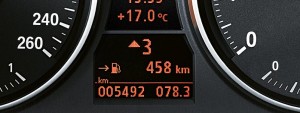U.S. Government Mandates New Fuel Efficiency Standards
The U.S. government unveiled new fuel-economy rules that will have a dramatic impact on Americans’ automotive purchasing habits. According to a joint statement released by the Environmental Protection Agency and Department of Transportation,  cars for the 2016 model year will, on average, have to be 34% more efficient than current models, averaging 35.5 mpg (6.6 l/100 km). The standard for 2009 cars was 26.4 mpg (8.9 l/100 km).
cars for the 2016 model year will, on average, have to be 34% more efficient than current models, averaging 35.5 mpg (6.6 l/100 km). The standard for 2009 cars was 26.4 mpg (8.9 l/100 km).
The gains are likely to come from incremental upgrades such as the use of more efficient tires, low-friction engine lubricants, and more efficient transmissions, as well as from the substitution of turbo-charged four- and six-cylinder motors for larger six- and eight-cylinder engines.
While some car makers are introducing alternative fuel vehicles, including the Nissan Leaf electric car, which goes on sale in December, and the Chevrolet Volt, which will be available later this year. Mini has been offering the Mini E electric vehicle to a limited number of customers and the number of diesels available in the U.S. has increased dramatically.
One automaker that has been offering cars with fuel-saving features is BMW, which brands its efforts as EfficientDynamics.
The BMW six-cylinder diesel engine with Variable Twin Turbo is representative of the use of more efficient motors. Available in the BMW 335d and X5 xDrive35d, the 3.0-liter engine offers 265 hp and an incredible 400 pound-feet of torque. The X5 gets 19 mpg (12.4 l/100 km) in the city and 26 mpg (9 l/100 km) on the highway.
The BMW 335d is the most efficient car ever offered by BMW of North America and gets 23 mpg (10.2 l/100 km) in the city and 36 mpg (6.5 l/100 km) on the highway.  But BMW doesn’t stop there. The company includes many fuel-sipping technologies as part of the EfficientDynamics program and every new BMW benefits from these innovations.
But BMW doesn’t stop there. The company includes many fuel-sipping technologies as part of the EfficientDynamics program and every new BMW benefits from these innovations.
The auto start stop function automatically switches off the engine when the car is at a standstill and in neutral, then restarts it as soon as the driver presses the clutch pedal again. Brake energy regeneration captures kinetic energy from braking and feeds it to the battery. Electric power steering only uses energy during steering maneuvers (as opposed to when the wheel is kept in a constant position).
The company fits tires with reduced rolling resistance to its cars. These tires employ special materials which reduce flexing and improve fuel economy. For cars with manual transmissions, a gear shift indicator in the middle of the dashboard recommends the most fuel-efficient gear to shift to.  With remarkable attention to detail, BMW also builds an air vent control system into its cars. This system opens electrically-controlled vents in front of the radiator only when cooling air is required, thereby reducing air resistance at other times, into its cars.
With remarkable attention to detail, BMW also builds an air vent control system into its cars. This system opens electrically-controlled vents in front of the radiator only when cooling air is required, thereby reducing air resistance at other times, into its cars.
BMW is not alone in its efforts. The Audi A3 TDI gets 42 mpg (5.6 l/100 km) on the highway and the Volkswagen Golf TDI gets41 mpg (5.73 l/100 km). The 2011 Ford Mustang will come with a V-6 engine that delivers 305 horsepower, 280 pound-feet of torque, and 31 mpg (7.6 l/100 km) on the highway. It comes with lower-rolling resistance tires and electric power steering, something Ford says it will use on 90% of its vehicles by 2012.





















